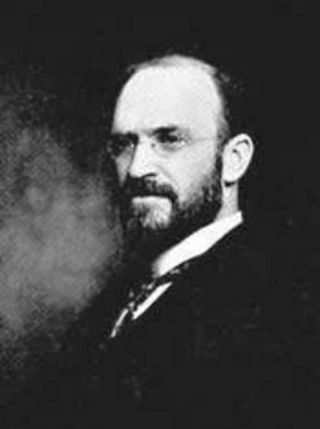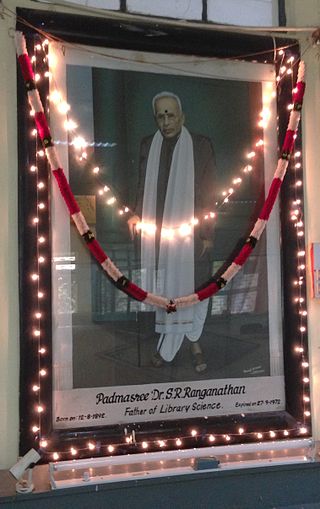Related Research Articles
The Bliss bibliographic classification (BC) is a library classification system that was created by Henry E. Bliss (1870–1955) and published in four volumes between 1940 and 1953. Although originally devised in the United States, it was more commonly adopted by British libraries. A second edition of the system (BC2) has been in ongoing development in Britain since 1977.
The Cutter Expansive Classification system is a library classification system devised by Charles Ammi Cutter. The system was the basis for the top categories of the Library of Congress Classification.

The Dewey Decimal Classification (DDC), colloquially known as the Dewey Decimal System, is a proprietary library classification system which allows new books to be added to a library in their appropriate location based on subject. It was first published in the United States by Melvil Dewey in 1876. Originally described in a 44-page pamphlet, it has been expanded to multiple volumes and revised through 23 major editions, the latest printed in 2011. It is also available in an abridged version suitable for smaller libraries. OCLC, a non-profit cooperative that serves libraries, currently maintains the system and licenses online access to WebDewey, a continuously updated version for catalogers.
The Library of Congress Classification (LCC) is a system of library classification developed by the Library of Congress in the United States, which can be used for shelving books in a library. LCC is mainly used by large research and academic libraries, while most public libraries and small academic libraries used the Dewey Decimal Classification system. The classification was developed by James Hanson, with assistance from Charles Martel, in 1897, while they were working at the Library of Congress. It was designed specifically for the purposes and collection of the Library of Congress to replace the fixed location system developed by Thomas Jefferson.

A library classification is a system of organization of knowledge in which sources are arranged according to the classification scheme and ordered very systematically. Library classifications are a notational system that represents the order of topics in the classification and allows items to be stored in the order of classification. Library classification systems group related materials together, typically arranged as a hierarchical tree structure. A different kind of classification system, called a faceted classification system, is also widely used, which allows the assignment of multiple classifications to an object, enabling the classifications to be ordered in many ways.

The Universal Decimal Classification (UDC) is a bibliographic and library classification representing the systematic arrangement of all branches of human knowledge organized as a coherent system in which knowledge fields are related and inter-linked. The UDC is an analytico-synthetic and faceted classification system featuring detailed vocabulary and syntax that enables powerful content indexing and information retrieval in large collections. Since 1991, the UDC has been owned and managed by the UDC Consortium, a non-profit international association of publishers with headquarters in The Hague, Netherlands.

Melville Louis Kossuth "Melvil" Dewey was an influential American librarian and educator, inventor of the Dewey Decimal system of library classification, a founder of the Lake Placid Club, and a chief librarian at Columbia University. He was also a founding member of the American Library Association. Although Dewey's contributions to the modern library are widely recognized, his legacy is marred by allegations of sexual harassment, racism, and antisemitism.

Shiyali Ramamrita Ranganathan was a librarian and mathematician from India. His most notable contributions to the field were his five laws of library science and the development of the first major faceted classification system, the colon classification. He is considered to be the father of library science, documentation, and information science in India and is widely known throughout the rest of the world for his fundamental thinking in the field. His birthday is observed every year as the National Librarian Day in India.
Dot-decimal notation is a presentation format for numerical data. It consists of a string of decimal numbers, using the full stop (dot) as a separation character.
A faceted classification is a classification scheme used in organizing knowledge into a systematic order. A faceted classification uses semantic categories, either general or subject-specific, that are combined to create the full classification entry. Many library classification systems use a combination of a fixed, enumerative taxonomy of concepts with subordinate facets that further refine the topic.

Paul Marie Ghislain Otlet was a Belgian author, entrepreneur, lawyer and peace activist; predicting the arrival of the internet before World War II, he is among those considered to be the father of information science, a field he called "documentation". Otlet created the Universal Decimal Classification, which would later become a faceted classification. Otlet was responsible for the development of an early information retrieval tool, the "Repertoire Bibliographique Universel" (RBU) which utilized 3x5 inch index cards, used commonly in library catalogs around the world. Otlet wrote numerous essays on how to collect and organize the world's knowledge, culminating in two books, the Traité de Documentation (1934) and Monde: Essai d'universalisme (1935).
The Nippon Decimal Classification is a system of library classification developed for mainly Japanese-language books maintained and revised by the Japan Library Association since 1948. Originally developed in 1929 by Kiyoshi Mori, the 10th and latest edition of this system was published in 2014. The decimal notation system is similar to the Dewey Decimal System, and the order of main classes is inspired from the Cutter Expansive Classification. The system is based upon using a three digit number to classify subjects, where more digits can be added if necessary and a decimal point is used to separate the third and fourth digit. The first division level is called a class, the second level is called a division, and the third level is called a section. Each '1-9' digit is used to represent a specific category, with the digit '0' being used to represent general works.
LibraryThing is a social cataloging web application for storing and sharing book catalogs and various types of book metadata. It is used by authors, individuals, libraries, and publishers.
The Korean Decimal Classification (KDC) is a system of library classification used in South Korea. The structure and main level classes of the KDC are based on the Dewey Decimal Classification. The KDC is maintained and published by the Classification Committee of the Korean Library Association. The first edition of the classification was published in 1964; the most recent edition is the sixth edition published in 2013. Almost all school and public libraries in South Korea use the KDC to organize their collections, as well as the National Library of Korea and some university libraries.
Knowledge organization (KO), organization of knowledge, organization of information, or information organization, is an intellectual discipline concerned with activities such as document description, indexing, and classification that serve to provide systems of representation and order for knowledge and information objects. According to The Organization of Information by Joudrey and Taylor, information organization:
examines the activities carried out and tools used by people who work in places that accumulate information resources for the use of humankind, both immediately and for posterity. It discusses the processes that are in place to make resources findable, whether someone is searching for a single known item or is browsing through hundreds of resources just hoping to discover something useful. Information organization supports a myriad of information-seeking scenarios.
The New Classification Scheme for Chinese Libraries is a system of library classification developed by Yung-Hsiang Lai since 1956. It is modified from "A System of Book Classification for Chinese Libraries" of Liu Guojun, which is based on the Dewey Decimal System.
James Duff Brown (1862–1914) was a British librarian, information theorist, music biographer and educationalist. Most of his life was spent in London.
Jack Mills was a British librarian and classification researcher, who worked for more than sixty years in the study, teaching, development and promotion of library classification and information retrieval, principally as a major figure in the British school of facet analysis which builds on the traditions of Henry E. Bliss and S.R. Ranganathan.
The British National Bibliography (BNB) was established at the British Museum in 1949 to publish a list of the books, journals and serials that are published in the United Kingdom and Republic of Ireland. It also includes information on forthcoming titles. This is the single most comprehensive listing of UK titles. UK and Irish publishers are obliged by legal deposit to send a copy of all new publications, including serial titles, to the BNB for listing. The BNB publishes the list weekly in electronic form: the last printed weekly list appeared in December 2011.
The London Education Classification is a library classification and indexing thesaurus used at the UCL Institute of Education. It was devised by D.J. Foskett and Joy Foskett. It was devised to address deficiencies in general classification schemes in dealing with education. It was originally devised in 1963, and revised in 1974. It is a faceted classification, inspired by the work of S.R. Ranganathan and of the Classification Research Group.
References
- ↑ The British Catalogue of Music Classification / compiled for the Council of the British National Bibliography Ltd. by E. J. Coates, F.L.A. London : Council of the British National Bibliography, 1960
- ↑ "Internet Archive: Details: The British Catalogue Of Music 1960". The Council of the British National Bibliography. 1960. Retrieved 2016-10-06.
- ↑ DDC Dewey Decimal Classification : proposed revision of 780 music / prepared under the direction of Russell Sweeney and John Clews with assistance from Winton E. Mathews Jr. Albany N.Y. : Forest Press, 1980. ISBN 0-910608-25-3
- ↑ Obituary: Information Professional: The Magazine of CILIP, the Library & Information Association (March 2021 p.55).
- ↑ "Archived copy". Archived from the original on 2008-05-12. Retrieved 2008-06-15.
{{cite web}}: CS1 maint: archived copy as title (link) - ↑ "(accessed 2015-12-17)". Slwa.wa.gov.au. 2013-08-20. Archived from the original on 2016-05-11. Retrieved 2016-10-06.
- ↑ "(accessed 2015-12-17)". Ecu.au.libguides.com. 2016-08-05. Retrieved 2016-10-06.